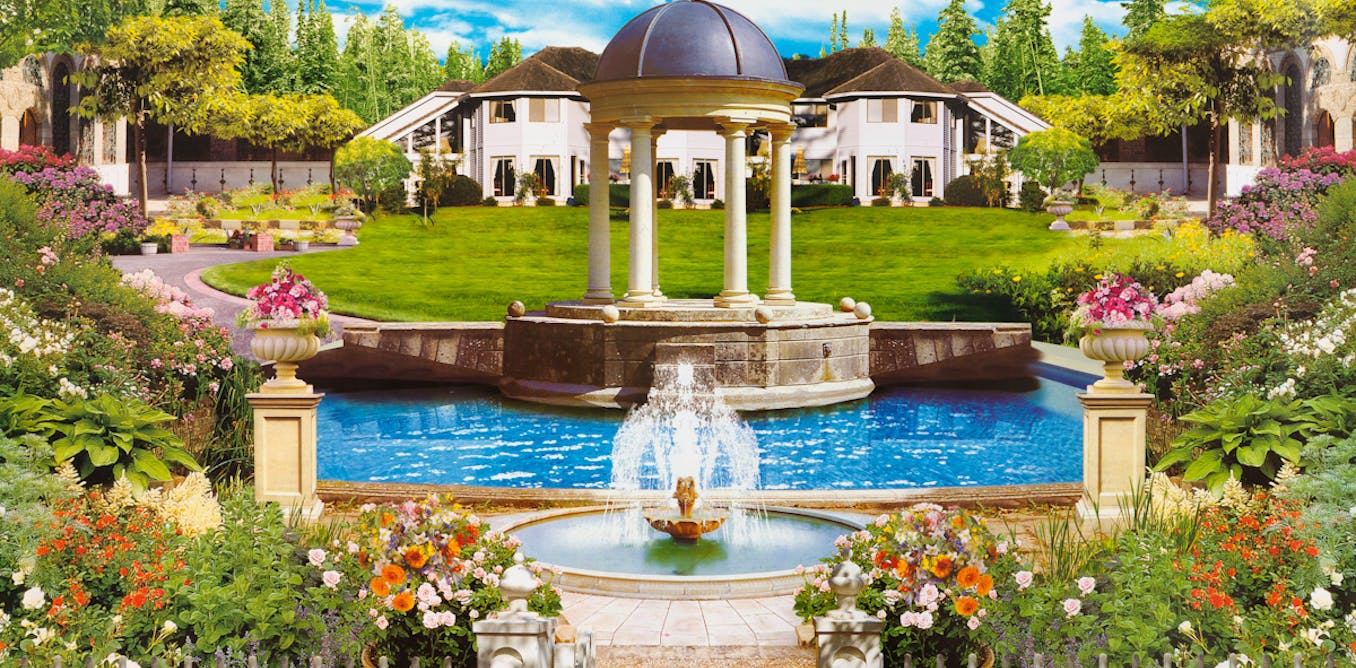[ad_1]
Egypt is a vacationer trip spot well-known for its archaeological web sites, pure magnificence and historic custom. Nevertheless fascination could also be found even in further mundane areas, as in an unusual kind of wall art work ubiquitous in Egyptian residences and small corporations.
Not pretty photos, the posters are photoshopped representations of fairly a number of pure environments or differing architectural varieties, juxtaposed in inconceivable strategies. These made-in-Egypt mandhar ṭabīɛī, or “pure landscapes” – which fluctuate in measurement from small, 50-by-35 cm framed pictures to wallpaper-scaled – reveal a really Egyptian kind of exoticism.
The entire posters illustrating this textual content come from my 2009 fieldwork in Cairo, purchased for just a few Egyptian kilos (decrease than $US1). These idealised pictures are displayed all through the nation, in private indoor areas, espresso retailers, consuming locations, hairdressers, and rural and concrete areas, nevertheless are significantly widespread throughout the arid Sinai countryside, Libyan desert and west Mediterranean coast.
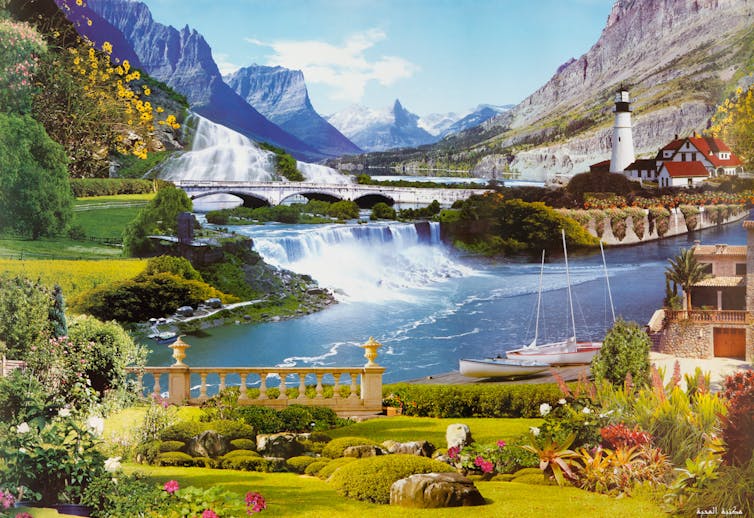
A lighthouse borrowed from Scandinavia enhances this 2009 poster.
The posters depict a mannequin of the “distinctive” not centred on uncommon date palms, flat fields or mundane sand dunes – all clichés utilized in vacationer catalogues to attract friends to Egypt. Instead, they particular a additional native aesthetic form, far far from Western necessities.
Nature’s Photoshop artisans
I at first incorrectly assumed that these posters had been low-cost Chinese language language merchandise filling a definite section Egyptian market. In fact, they’re designed and produced throughout the Shubra neighbourhood of Cairo or the shut by suburbs. Maktaba al-Maḥaba, a critical Coptic Christian bookstore (مكتبة المحبة القبطية), distributes their catalogues all through Egypt (and apparently all by the North Africa space, as I’ve since seen some posters in Tunisia’s Jerid oasis and the Moroccan Rif).
The first design software program in these Egyptian cut-and-paste compositions is clearly Photoshop (or a similar software program program). The craftsmen current good mastery of pasting, fusion, blurring, cropping, scaling, duplication and totally different methods, creating on their laptop screens three-dimensional scenes encompassing all the proper of varied continents – even when it means implausible coexistences and actual points with scale.
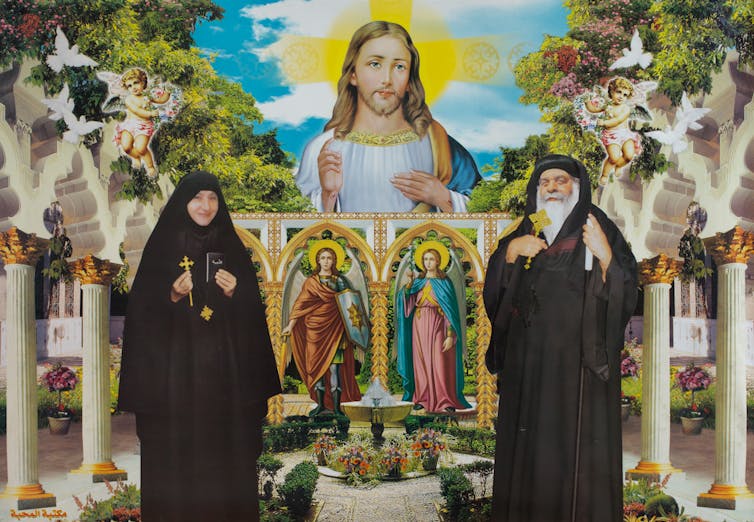
Though individuals are unusual in these posters, proper right here we see the acknowledged Copt saint Tamav Irene (1936-2006) and the Pope Pope Cyril VI (1902-1971).
The artisans of the Maktaba al-Maḥaba shoppe, who don’t hesitate to cater to the Christian neighborhood by printing Jesus Christ or the late Pope Shenouda III in these bucolic settings, undoubtedly inherited the Coptic iconographic know-how behind the store’s infinite manufacturing of pious pictures depicting triumphant saints, benevolent popes and monks, and struggling martyrs.
Snow, rainforests, Christs and Chinese language language pagodas
Water is everywhere in these posters, its presence seemingly required by prospects. It could be a sea, a lake, a river (usually with fanciful route), or, the truth is, these elaborate fountains.
The other prerequisite is greenery and a rich palette of florals – regardless, as soon as extra, of botanical, agronomic or ecological incongruities and impossibilities. The posters are saturated with yard motifs, leaving some home for the sky nevertheless little or no room for folks or animals.
Architectural parts mirror not merely Islamic motifs (columns, ceramics) however as well as varieties pretty abroad to Egypt, equal to Californian villas, Chinese language language pagodas and Scandinavian lighthouses. Completely different distinctive landscapes embrace copy pictures of snowy Swiss mountains with equatorial rainforest waterfalls, punctuated by the palace of Versailles or totally different Renaissance-style developing, plus Islamic ponds with lush floral preparations – and perhaps a yacht or ice floe throughout the background.
Usually, there’s a photographic enlargement of an English yard in its autumn glory. Nevertheless, often, pure nature is not ample, and the thirst for exoticism triumphs.
What’s exoticism? What’s ‘pure’?
These posters are prominently displayed all through Egypt, offering seen enjoyment of gasoline stations and native eateries. In Siwa, a distant oasis throughout the Libyan desert of Egypt, I observed them throughout the marbūɛa (entrance room) of houses.
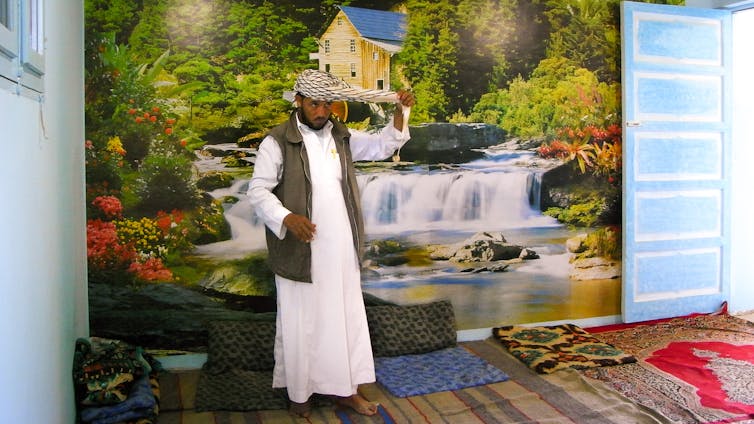
The lounge inside in a newly constructed residence throughout the Siwa Oasis of Egypt’s Libyan Desert.
Siwa inhabitants do not see their panorama as considerably distinctive or fascinating. Within the meantime, vacationers who come to Siwa do not give consideration to the world’s true agro-ecosystem nevertheless look previous at a additional acquainted scene, the “already acknowledged” oasis of their Western imagery, an iconic Eden panorama that conforms with their very personal notion of exoticism.
This comment helps social anthropologist Gérard Lenclud, who talked about that panorama is:
“the product of the view of any individual who’s ‘foreigner’ to it. Man doesn’t think about elaborating a landscaped illustration of the place to which he is related and the place he works or lives.”
Distinctive is always found elsewhere, previous the horizon.
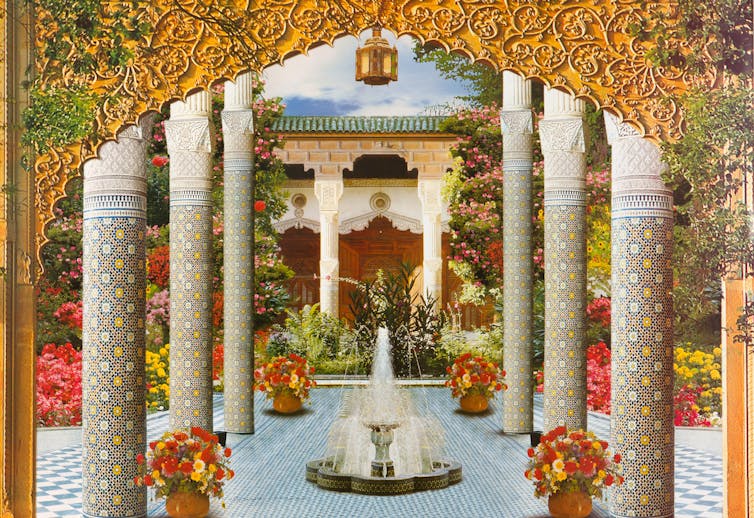
Fountains are recurrent parts of Egyptian posters.
What does this reveal about Egyptians’ supreme of nature? In accumulating pictures from totally different eras and areas, these posters create an distinctive home located someplace between the nostalgia for a misplaced Eden and the promise of Paradise. The inclusion of Islamic golden-age gardens, Swiss chalets and Atlantic lighthouses moreover reveals the attractiveness of a globalised world.
The amassing of parts speaks for itself: saturation could be the vital factor thought of frequent aesthetics, part of the pursuit of sensorial experience. The beholders of these mandhar ṭabīɛī constructions do not distinguish between “pure” nature and artificial renditions. In interviews I found that Siwa residents each do not uncover this phoney flavour or do not care about its inauthenticity.
Needs of lush gardens
What Egyptian prospects do clearly select is that the posters’ iconic jumble must be organised in accordance with repeating patterns of three predominant parts: flora, water, and construction. A couple of of those parts reappear from poster to poster – the equivalent fountain could also be recognised stretched a bit proper right here, or with a novel basin there.
I would unwittingly observe the biography of some key patterns as I vainly sought proof of a similar craft across the globe. The mill usually seen throughout the midst of a lush tropical vegetation, as an example, is “sampled” from a poster entitled “Glade Creek Grist Mill, Babcock State Park, West Virginia” (credited to Robert Glusic). The distinctive is an already romanticised depiction of a vacationer attraction in Babcock State Park in West Virginia, United States.
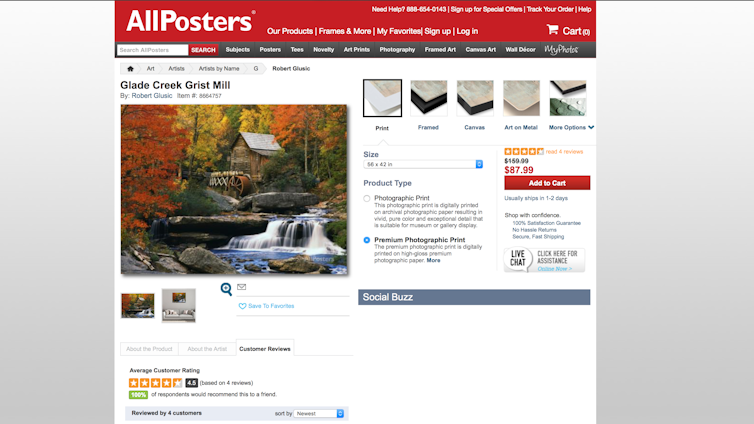
This West Virginia waterfall is sampled in some Egyptian posters, along with the one throughout the Siwa residence, confirmed above.
In Egypt, a simple copy of this image would not suffice. That distinguishes its frequent aesthetic customized from Europe’s, the place, in accordance with Jean-Claude Chamboredon throughout the collective e book, Defending Nature: historic previous and beliefs, “the countryside as an idyllic social setting outcomes from an prolonged strategy of progressive disappearance of the agricultural proletariat … given that second half of the nineteenth century”.
The French countryside has turn into an ideal, neutral home whose very constructing (by a historic previous of social struggles) is erased and altered with a narrative of an real, standard and beautiful seasonally-changing matter. (I recall now the plywood-mounted poster of a continental forest that my dad and mother proudly displayed in our entrance room in Le Havre, France.)
Not so in North Africa and Egypt. In deserts, it seems, the parents dream of lush gardens and Italianate palaces that allow them to be swept away, if only for a second, from arid native soil.
[ad_2]
